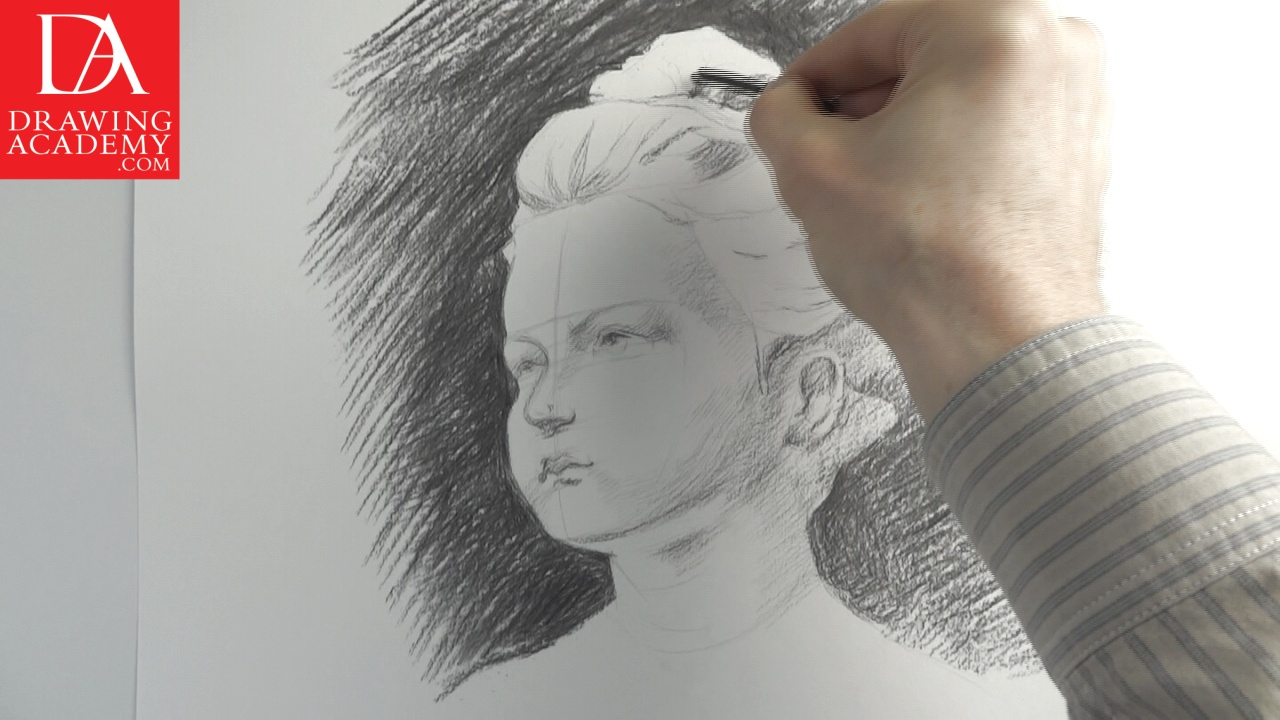Discover How to Draw Children in Charcoal
In this video lesson you will discover How to Draw Children on example of the girl’s portrait in charcoal.
Enroll in the Drawing Academy Course
Pay once - Enjoy forever!
Only $297
How to Draw Children
The girl’s bust is placed against a quite dark background. There’s a very pronounced contrast between the white cast and dark backdrop. We continue the portrait of the girl shading the background in charcoal. Wider charcoal strokes are used loosely to block the area of the background.
Charcoal along with earth pigments are the oldest drawing mediums known to man. Charcoal was used for making preparatory drawings for panel painting and frescos. Powdered charcoal was also used for transferring images from cartoons into canvases, panels, or plaster for fresco. As an expressive medium in its own right, charcoal emerged during the Renaissance time.
One of the best examples of the charcoal drawing was crafted by Leonardo da Vinci, around 1499-1500, and it is now called “The Burlington House Cartoon”. This drawing is displayed in the National Gallery in London. Despite seeing it hundreds of times during my daily visits to the Gallery, I’m astonished every time I see it again. The drawing was intended as a preparatory cartoon in actual size, for the painting of the Virgin Mary; her mother, Saint Anne; the Christ, and his cousin, Saint John the Baptist; all set in a wild mountainous landscape. This full-size preparatory study for a painting was destined to be punctured, or incised, in order for the drawing’s outlines to be transferred into canvas or panel. However, this masterpiece is intact. It has been left as an artwork in its own right, as a finished drawing.
Fine artists found charcoal very handy, as a medium, because they could easily alter an image by erasing parts of it.

Various supports can be used for a charcoal drawing. Almost any good-quality drawing paper is suitable for the task. However, you may find that softer paper, with a rough grain, holds charcoal particles better. An acid-free pure rag paper suits the job very well. Alternatively, using a very smooth paper for illustrations would present more challenges than benefits for a charcoal drawing, and therefore shall be avoided.
Dark charcoal lines can be smoothed out with a paper stump. As the area of the background is quite wide, we are using an improvised tool – a palette knife wrapped with a paper towel. The springy palette knife is a perfect choice, due to its suppleness and wide contact area. Working with the stump, we even-out the tone of the background, blending dark charcoal strokes into one mass.
A paper stump is also used for smoothing shadows and mid-tones of the girl’s head. More delicate pressure is required here.
For smaller details, we use the ready-made paper stump. It should be available in any art store selling charcoal sticks. A paper stump usually has two pointed ends. The tip can be used for fine adjustments, or the broad edge of the tip can be used for softening outlines and gradually blending tones. Circular or linear movements of the paper stump produce different results, depending on how much charcoal is being smoothed.
The same principle applies when working with the stump – it’s best to work on the whole drawing simultaneously, rather than concentrating your full attention on just one particular area of the drawing.
The second layer of the charcoal is applied to the background. This time the background is toned down with shorter, darker, and denser lines.
The process of covering wide areas of drawing with charcoal is quite fast.
More attention to precision needs to be paid to the areas where the background borders with the white bust. Although the erasing of charcoal is easy, it’s better to avoid unnecessary mess to start with.
Denser charcoal strokes can now be smoothed with a hog bristle brush. Medium sized brush number 10 to 12 is quite stiff. Through short parallel brushstrokes, the background tone is being evened out. The brush swipes out about half of the charcoal, so the tone is becoming lighter and smoother. At the same time, the brushwork makes the drawing softer. You may wish to place a piece of paper under the drawing, thus protecting your working environment from being stained by the “removed” particles of the charcoal. All brushwork can be done with brushstrokes going in one direction, or you can vary the strokes angles to achieve a more artistic effect.





Comments are closed.